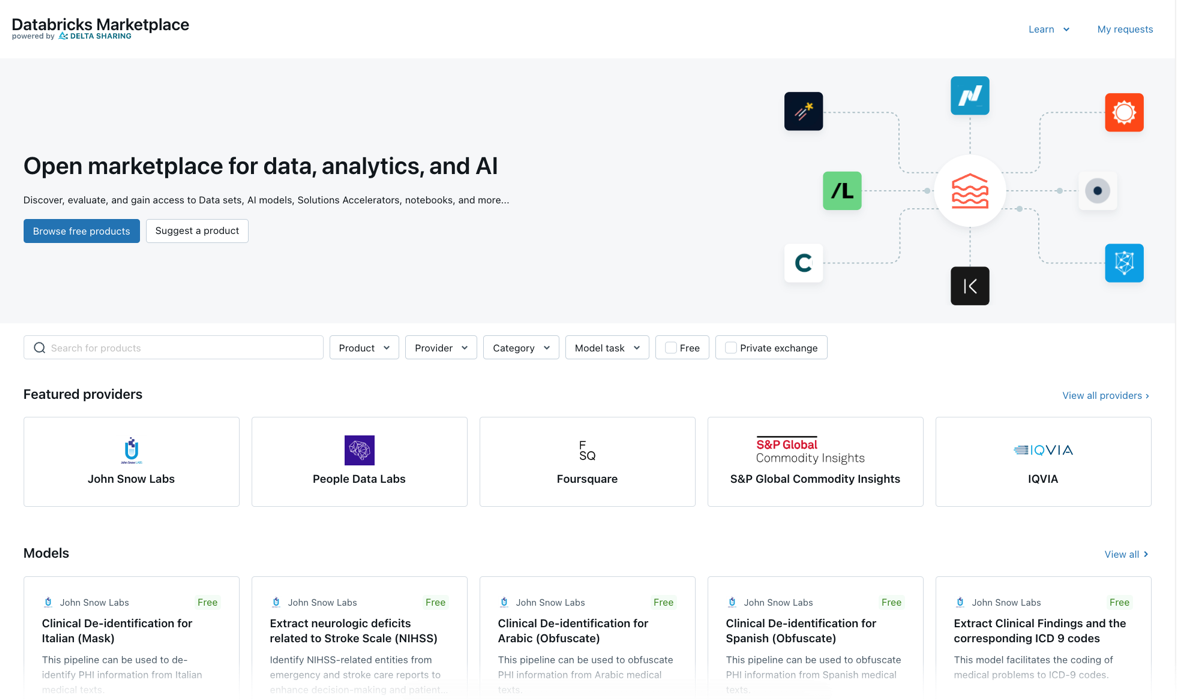What is Databricks Marketplace?
This article introduces Databricks Marketplace, an open forum for exchanging data products. Databricks Marketplace takes advantage of Delta Sharing to give data providers the tools to share data products securely and data consumers the power to explore and expand their access to the data and data services they need.

What kinds of data assets are shared on Databricks Marketplace?
Marketplace assets include datasets, Databricks notebooks, Databricks Solution Accelerators, and machine learning (AI) models. Datasets are typically made available as catalogs of tabular data, although non-tabular data, in the form of Azure Databricks volumes, is also supported. Solution Accelerators are available as clonable Git repos.
How do consumers get access to data in Databricks Marketplace?
To find a data product you want on the Databricks Marketplace, simply browse or search provider listings.
You can browse:
- The Open Marketplace, which does not require access to a Databricks workspace.
- The Databricks Marketplace on your Databricks workspace. Just click
 Marketplace.
Marketplace.
To request access to data products in the Marketplace, you must use the Marketplace on a Databricks workspace. You do not need a Databricks workspace to access and work with data once it is shared, although using a Databricks workspace with Unity Catalog enabled lets you take advantage of the deep integration of Unity Catalog with Delta Sharing.
Some data products are available to everyone in the public marketplace, and others are available as part of a private exchange, in which a provider shares their listings only with member consumers. Whether public or private, some data products are available instantly, as soon as you request them and agree to the terms. Others might require provider approval and transaction completion using provider interfaces. In either case, the Delta Sharing protocol that powers the Marketplace ensures that you can access shared data securely.
Get started accessing data products
To learn how to get started as a data consumer:
- Using a Databricks workspace that is enabled for Unity Catalog, see Access data products in Databricks Marketplace (Unity Catalog-enabled workspaces).
- Using third-party platforms like Power BI, pandas, or Apache Spark, along with Databricks workspaces that are not enabled for Unity Catalog, see Access data products in Databricks Marketplace using external platforms.
How do providers list data products in Databricks Marketplace?
Databricks Marketplace gives data providers a secure platform for sharing data products that data scientists and analysts can use to help their organizations succeed. Databricks Marketplace uses Delta Sharing to provide security and control over your shared data. You can share public data, free sample data, and commercialized data offerings. You can share data products in public listings or as part of private exchanges that you create, making listings discoverable only by member consumers. In addition to datasets, you can also share Databricks notebooks and other content to demonstrate use cases and show customers how to take full advantage of your data products.
Get started listing data products
To list your data products on Databricks Marketplace, you must:
- Have a Databricks account and premium workspace that is enabled for Unity Catalog. You do not need to enable all of your workspaces for Unity Catalog. You can create one specifically for managing Marketplace listings.
- Apply to be a provider through the Databricks Data Partner Program. Alternatively, if you only want to share data through private exchanges, you can use the self-service signup flow in the provider console. See Sign up to be a Databricks Marketplace provider.
- Review the Marketplace provider policies.
To learn how to get started, see List your data product in Databricks Marketplace.
View a demo
This video introduces Databricks Marketplace, shows how consumers access listings, and demonstrates how providers create them.
Feedback
Coming soon: Throughout 2024 we will be phasing out GitHub Issues as the feedback mechanism for content and replacing it with a new feedback system. For more information see: https://aka.ms/ContentUserFeedback.
Submit and view feedback for